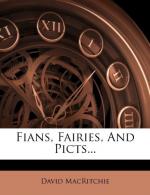Of the various Hebridean specimens of these buildings, very interesting and complete descriptions have been given by the late Captain Thomas, R.N.,[56] and Sir Arthur Mitchell,[57] who visited some of them together in 1866. Referring to the most modern examples of this kind of structure, the latter writer says:—“They are commonly spoken of as beehive houses, but their Gaelic name is bo’h or bothan. They are now only used as temporary residences or shealings by those who herd the cattle at their summer pasturage; but at a time not very remote they are believed to have been the permanent dwellings of the people.” And he thus describes his first sight of the beehive houses:—
“I do not think
I ever came upon a scene which more surprised me,
and I scarcely know
where or how to begin my description of it.
“By the side of a burn which flowed through a little grassy glen ... we saw two small round hive-like hillocks, not much higher than a man, joined together, and covered with grass and weeds. Out of the top of one of them a column of smoke slowly rose, and at its base there was a hole about three feet high and two feet wide, which seemed to lead into the interior of the hillock—its hollowness, and the possibility of its having a human creature within it being thus suggested. There was no one, however, actually within the bo’h, the three girls, when we came in sight, being seated on a knoll by the burn-side, but it was really in the inside of these two green hillocks that they slept, and cooked their food, and carried on their work, and—dwelt, in short."[58]
These two “green hillocks,” and other structures of the same nature, are shown in the accompanying diagrams[59] (Plates I.-XVI.), which explain their formation better than any written description. It is enough here to state that they are built of rough stone, without any mortar. “Though the stone walls are very thick,” says my authority (p. 62), “they are covered on the outside with turf, which soon becomes grassy like the land round about, and thus secures perfect wind and water tightness.” Sometimes they occur in groups, as those shown in Plate III.; of which scene Captain Thomas justly remarks that “at first sight it may be taken for a picture of a Hottentot village rather than a hamlet in the British Isles."[60] Here there is little or no grassy covering outside, however; and consequently none of the hillock-like effect. But this is very well shown in Plates VI. and VIII. Of the “agglomeration of beehives” pictured in the latter, Sir Arthur Mitchell observes:—“It has several entrances, and would accommodate many families, who might be spoken of as living in one mound, rather than under one roof” (op. cit. pp. 64-5). Of another such dwelling, now ruined, he says that it could have accommodated “from forty to fifty people.”




